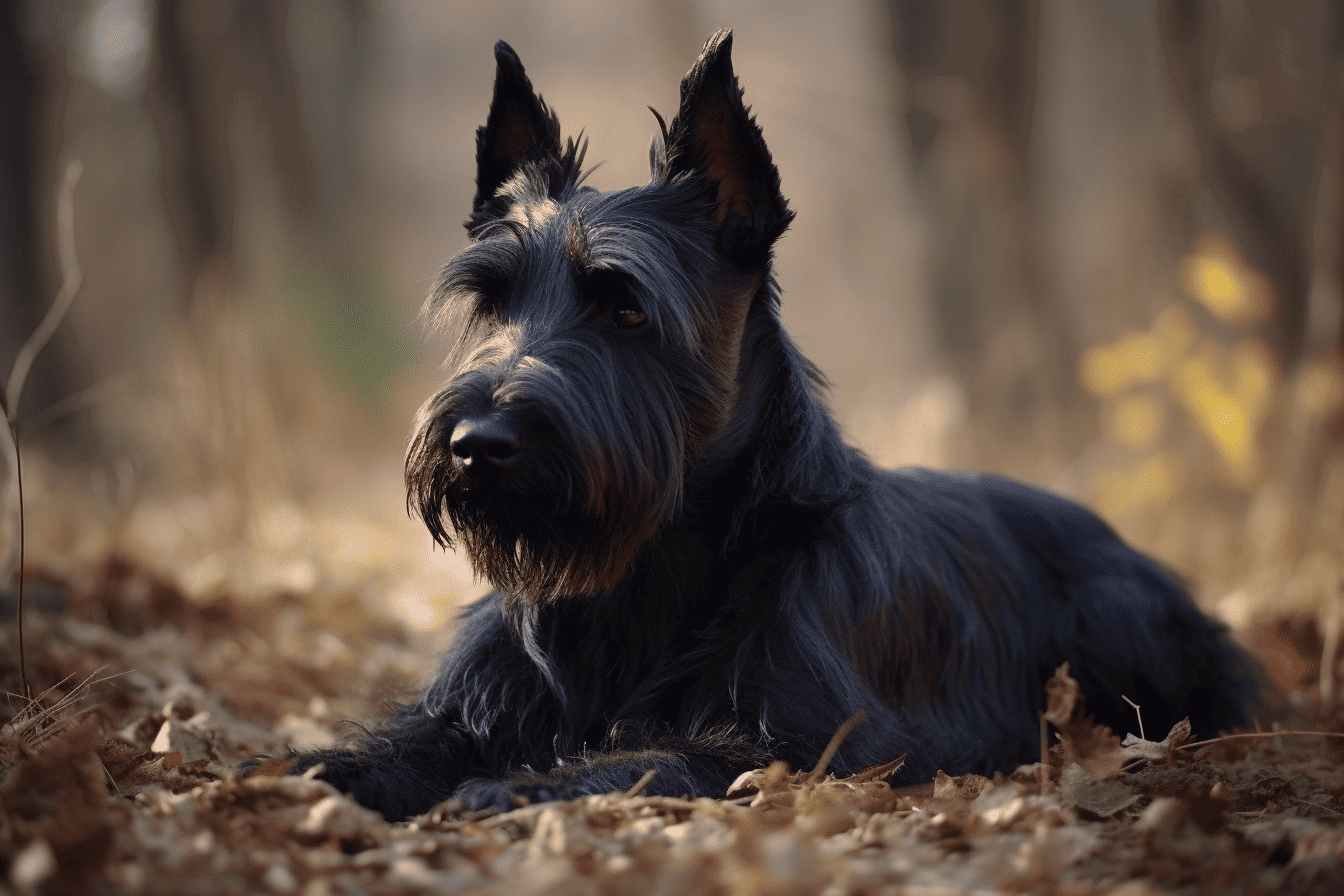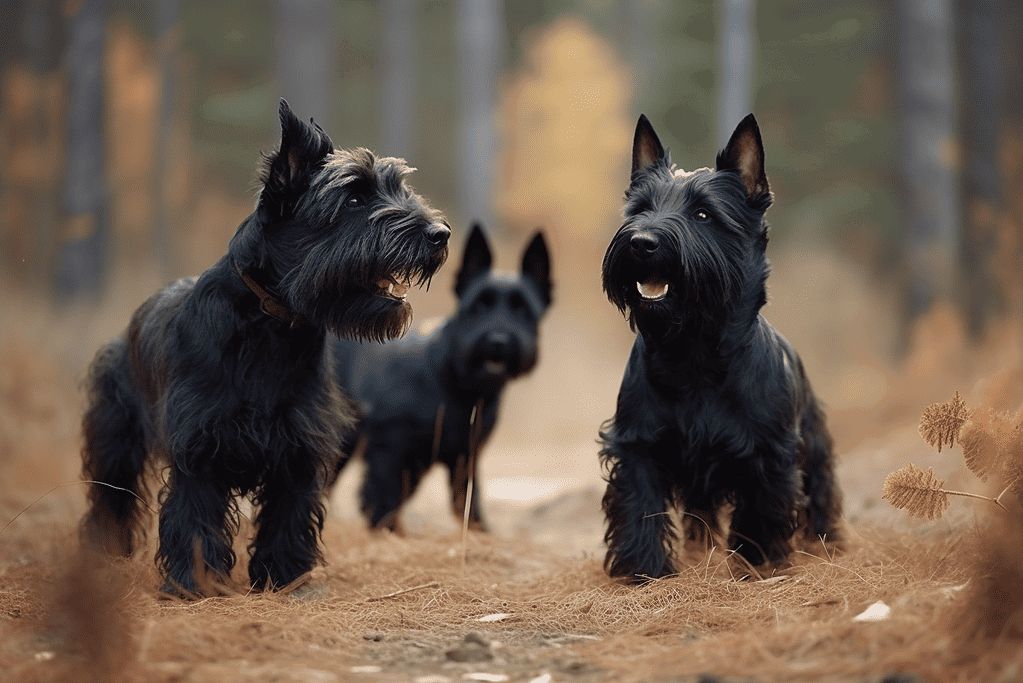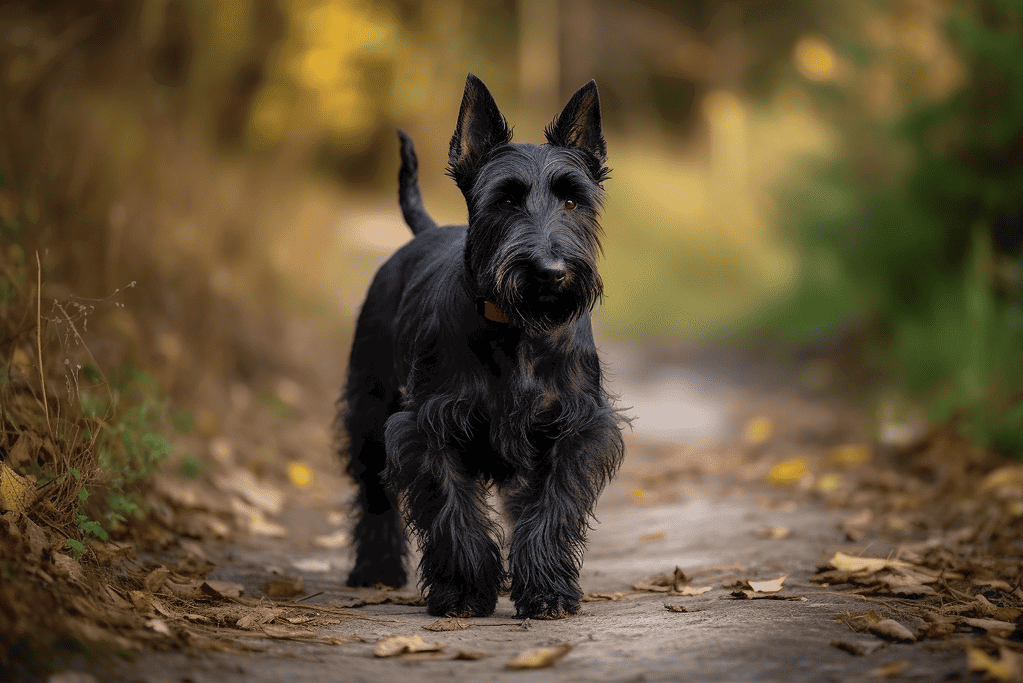
Scottish Terrier Dogs: Information, Images, Care Tips and More
Shortcuts
Scottish Terriers possess a delightful allure, capturing the hearts of numerous celebrities and royalty across the ages. While they may seem distant initially, upon getting acquainted, you’ll discover their personalities are as equally endearing as their appearances.
Breed Overview

Height
10-11 inches
Weight
18-22 pounds
Lifespan
12-15 years
Colors
Black, Brindle, Wheaten
Suitable for
Individuals and older families looking for an independent companion
Temperament
Independent, Confident, Alert, Loyal, Playful


Height
10-11 inches
Weight
18-22 pounds
Lifespan
12-15 years
Colors
Black, Brindle, Wheaten
Suitable for
Individuals and older families looking for an independent companion
Temperament
Independent, Confident, Alert, Loyal, Playful

Scottish Terriers are delightful and faithful companions, but they may require some time to establish trust and form a bond with you. Therefore, it’s essential to do thorough research prior to adopting a Scottish Terrier puppy. This article aims to provide valuable insights into this unique breed and its particular care requirements, ensuring that you and your Terrier are well-suited for a wonderful life together.
Characteristics
Energy

Health

Sociability

Trainability

Lifespan


Enjoying this read?
We publish this content for free to generate interest in our Premium members' area. By subscribing, you can ask the writer any questions related to pet care and this article, get access to 100+ Premium Pet Care Guides and go Ad-Free with DogFix Premium for $2.99.
Health Conditions
Overall, Scottish Terriers tend to be quite robust and healthy canines; however, they are not exempt from certain hereditary health issues. A mild condition they may experience is Scottie cramp, a genetic neurological disorder characterized by brief muscle spasms usually triggered by stress or physical activity. Thankfully, these spasms are not painful for the dog and typically subside within 10 minutes.
Minor Conditions
- Allergies
- Ear Infections
- Skin Problems
- Hypothyroidism
- Patellar Luxation
Serious Conditions
- Von Willebrand’s Disease
- Cushing’s Disease
- Bladder Cancer
- Scottie Cramp
- Brain Tumors



Selecting a Scottish Terrier Puppy: What to Keep in Mind
There’s no shortage of healthy Scottish Terrier puppies available from responsible breeders and dog shelters, but it’s essential to do your homework before choosing your new friend. Trustworthy breeders will often hold validated Kennel Club memberships. Additionally, they possess a wealth of knowledge about the breed and adhere to best breeding practices while demonstrating genuine affection and care for their puppies.
Be sure to verify that the puppies have been given the appropriate vaccinations and deworming treatments for their age, and don’t hesitate to ask for a copy of their health records. Welcoming a Scottish Terrier into your home means inviting a loving and affectionate companion to join your family. However, keep in mind that these independent pups can sometimes present a challenge when it comes to training.

Personality and Intelligence of Scottish Terriers
As a breed, Scottish Terriers possess notable intelligence, loyalty, and spiritedness. Yet, they may appear reserved and self-reliant around unfamiliar people. Ideally suited for seasoned dog owners, these terriers thrive with consistent training that acknowledges their autonomous nature.

Are Scottish Terriers Suitable Family Pets?
Scottish Terriers are naturally inclined to provide companionship, as it’s embedded in their genes. Once they forge a bond with their owner and family members, they exhibit immense loyalty and vigilance, keeping an eye out for any potential hazards. While they may seem reserved around strangers, these dogs relish being actively involved in their family’s daily life. It’s important for them to live indoors and thrive in households where at least one person is present for the majority of the day. Long periods of solitude can induce stress in this breed.
In most cases, Scottish Terriers enjoy spending time with younger children. However, it’s crucial to teach children the appropriate way to interact with dogs to avoid triggering any aggressive responses. Supervision is essential, especially in the early days of socialization.

Can Scottish Terriers Coexist with Other Animals?
Integrating a Scottish Terrier with other pets can be quite a challenge. These dogs tend to be territorial and cautious, and they are not particularly renowned for their social skills with other dogs. As such, early socialization is crucial for a successful cohabitation between a Scottish Terrier and another dog in the same household. It’s important to expose your Scottish Terrier puppy to friendly and gentle dogs, making sure their initial interactions are short and taking place in a secure environment. Never leave your Scottish Terrier alone with another dog until you are confident in their mutual trust.
Regarding other animals, it is essential for owners to understand that their Scottish Terrier may not thrive in a home with cats or small pets. This breed was originally developed for hunting foxes, badgers, and rodents, which means they have a strong prey drive and the instinct to chase small animals.

Important Considerations for Scottish Terrier Ownership
Scottish Terriers tend to be healthy and endearing pets, but they do require patience and dedication for successful training. Once you’ve gained their trust by catering to their unique needs, the bond you share will be truly rewarding. To build a joyful and harmonious relationship with your furry friend, be sure to research their specific requirements thoroughly.

Nutritional and Dietary Needs of Scottish Terriers
Adorable as they may be, Scottish Terriers have a tendency to gain weight due to their low exercise needs, making it crucial for pet parents to keep a close eye on their food consumption. A nutritious diet rich in protein and low in grains and carbs can work wonders for these little furballs. Opt for low-calorie treats to avoid overindulging them. Some Scotties may experience patellar luxation, so it is wise to consult your veterinarian regarding the suitability of hip and joint supplements in their diet. Additionally, since this breed is susceptible to cataracts and progressive retinal atrophy (PRA), be sure to ask your vet about the necessity of eye health supplements as well.

Exercise Recommendations for Scottish Terriers
Moderation is key here. A daily walk of 30 to 45 minutes at a relaxed pace is ideal for these little dogs. They also love to play; giving them the opportunity to frolic in a yard with rope toys or interactive toys can be a real treat. However, it’s crucial to avoid overly strenuous activities, as some Scotties may suffer from “Scottie cramps” when they overexert themselves. Their lower energy levels make them well-suited for apartment living.

Essential Training Guidelines for Scottish Terriers
The Scottish Terrier breed is known for its independence, which can make training a bit of a challenge. As a result, it’s essential to begin training your Scottish Terrier puppy from day one, as autonomy is in their gene-pool! This trait can be somewhat frustrating, especially for first-time dog owners. To overcome this, adapt your training approach to suit the Scottish Terrier’s independent nature, keeping sessions short and engaging.
Begin with a few basic obedience commands and gradually reinforce their responses. Thankfully, Scottish Terriers are highly receptive to positive praise and treats, responding exceptionally well to encouragement and clear instructions. These efforts will significantly contribute to your Scottish Terrier becoming more attuned to your vocal commands and willing to listen.

Grooming Essentials for Your Scottish Terrier
As Scottish Terriers are susceptible to dental issues, maintaining good oral hygiene is crucial for their overall health. It’s important to start training them for toothbrushing from a young age, ensuring they become familiar with the process. Offering dental chews and treats is also a great way to support their dental health. Although they don’t shed excessively, with their mix of coarse and soft coats, weekly brushing is essential to remove loose hairs and prevent matting. Slicker brushes and steel combs are excellent grooming tools for this breed.
To save time on brushing, you can also opt for professional grooming services every couple of months to maintain a short, manageable coat. Since Scottish Terriers often suffer from dry skin, frequent baths aren’t necessary. A monthly bath using a shampoo and conditioner with soothing or anti-itch properties should suffice.


Comparing Male and Female Scottish Terriers
It’s a common misconception that female Scottish Terriers are easier to train than their male counterparts; however, there is no concrete evidence to support this belief. In reality, there are no significant differences between the genders when it comes to temperament or trainability. While males may be slightly larger and heavier than females, the difference is minimal, with only a few inches and pounds separating them. The primary factor impacting behavior is whether the dog has been spayed or neutered. Unaltered dogs can exhibit undesirable behaviors such as aggression, excessive barking, territorialism, and possessiveness over food and toys. Training can also be more challenging for these dogs, especially considering the Scottish Terrier’s naturally independent disposition.

Intriguing Fact #1 About Scottish Terriers
Scottish Terriers have long been cherished by both politicians and royalty. King James VI of Scotland was particularly fond of these charming dogs and was instrumental in promoting their popularity throughout Europe. He even sent six Scottish Terriers as a gift to France! Famously, Queen Victoria also loved the breed, while President Roosevelt was seldom seen without his cherished Scottish Terrier companions. A testament to this bond can be found at the Franklin Delano Roosevelt Memorial in Washington DC, where a statue of his Scottish Terrier, Fala, proudly stands beside the president’s own likeness.

Fascinating Fact #2 About Scottish Terriers
Remarkably, a majority of Scottish Terriers can trace their lineage back to a single female named Splinter II. Deservingly dubbed the “Mother of the Scottish Terrier Breed,” she was owned by JH Ludlow, who also happened to establish the Scottish Terrier Club of England.

Interesting Fact #3 About Scottish Terriers
The darling Scottie Dog became a cherished addition to the Monopoly game in the 1950s, representing Mr. Monopoly’s loyal companion. To this day, it’s a fan favorite and even secured its spot in the game through a 2017 online poll.

Concluding Thoughts on the Scottish Terrier Breed
Scottish Terriers thrive with knowledgeable dog owners and find immense joy in the company of their human family. While they may not show much enthusiasm towards strangers, they delight in being involved in their home’s daily activities. Ideally, this breed should be the sole pet in the household, but their vibrant personalities will undoubtedly leave a lasting impression. Nurturing a Scottish Terrier’s exceptional character requires effort, but your commitment will be rewarded with a faithful, devoted, and affectionate companion. Over time, you’ll come to cherish their independent nature, as they express love and care in their own distinct manner.


Didn’t find what you need? Use the search!
Search our database of over hundreds of posts with up-to-date information from our experts and veterinarians.

